brakes FIAT STILO 2006 1.G Owners Manual
[x] Cancel search | Manufacturer: FIAT, Model Year: 2006, Model line: STILO, Model: FIAT STILO 2006 1.GPages: 274, PDF Size: 4.76 MB
Page 96 of 274
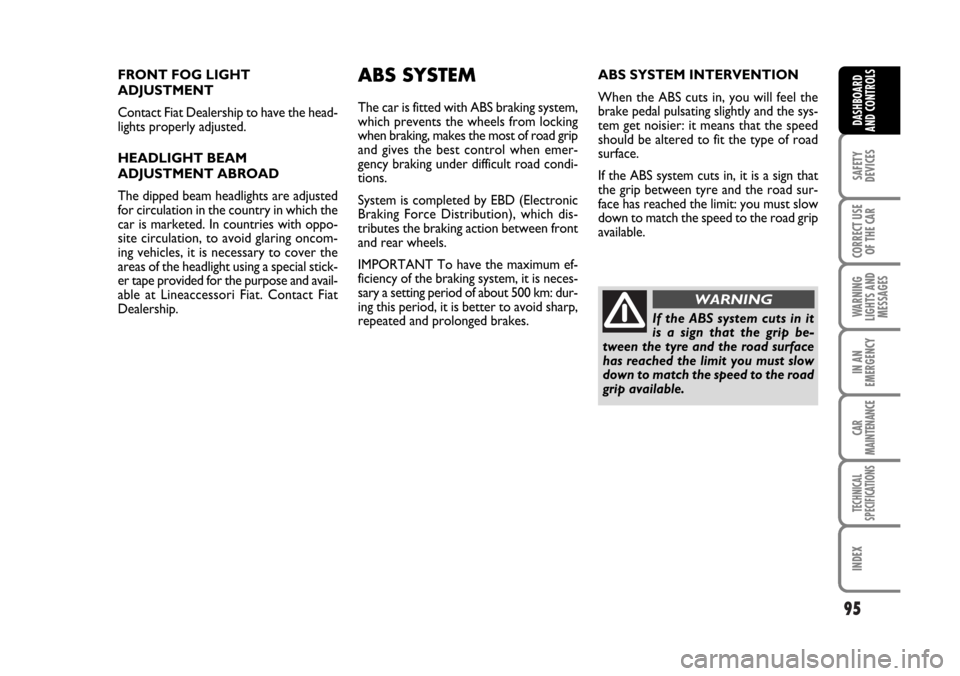
95
SAFETY
DEVICES
CORRECT USE
OF THE CAR
WARNING
LIGHTS AND
MESSAGES
IN AN
EMERGENCY
CAR
MAINTENANCE
TECHNICAL
SPECIFICATIONS
INDEX
DASHBOARD
AND CONTROLS
FRONT FOG LIGHT
ADJUSTMENT
Contact Fiat Dealership to have the head-
lights properly adjusted.
HEADLIGHT BEAM
ADJUSTMENT ABROAD
The dipped beam headlights are adjusted
for circulation in the country in which the
car is marketed. In countries with oppo-
site circulation, to avoid glaring oncom-
ing vehicles, it is necessary to cover the
areas of the headlight using a special stick-
er tape provided for the purpose and avail-
able at Lineaccessori Fiat. Contact Fiat
Dealership.ABS SYSTEM
The car is fitted with ABS braking system,
which prevents the wheels from locking
when braking, makes the most of road grip
and gives the best control when emer-
gency braking under difficult road condi-
tions.
System is completed by EBD (Electronic
Braking Force Distribution), which dis-
tributes the braking action between front
and rear wheels.
IMPORTANT To have the maximum ef-
ficiency of the braking system, it is neces-
sary a setting period of about 500 km: dur-
ing this period, it is better to avoid sharp,
repeated and prolonged brakes.ABS SYSTEM INTERVENTION
When the ABS cuts in, you will feel the
brake pedal pulsating slightly and the sys-
tem get noisier: it means that the speed
should be altered to fit the type of road
surface.
If the ABS system cuts in, it is a sign that
the grip between tyre and the road sur-
face has reached the limit: you must slow
down to match the speed to the road grip
available.
If the ABS system cuts in it
is a sign that the grip be-
tween the tyre and the road surface
has reached the limit you must slow
down to match the speed to the road
grip available.
WARNING
Page 102 of 274
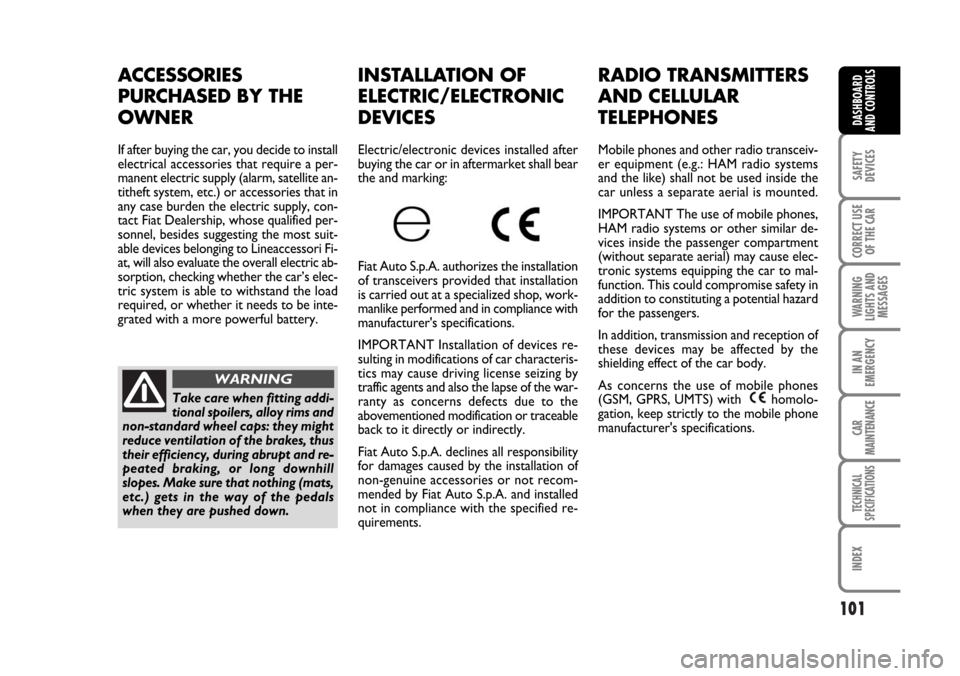
101
SAFETY
DEVICES
CORRECT USE
OF THE CAR
WARNING
LIGHTS AND
MESSAGES
IN AN
EMERGENCY
CAR
MAINTENANCE
TECHNICAL
SPECIFICATIONS
INDEX
DASHBOARD
AND CONTROLS
ACCESSORIES
PURCHASED BY THE
OWNER
If after buying the car, you decide to install
electrical accessories that require a per-
manent electric supply (alarm, satellite an-
titheft system, etc.) or accessories that in
any case burden the electric supply, con-
tact Fiat Dealership, whose qualified per-
sonnel, besides suggesting the most suit-
able devices belonging to Lineaccessori Fi-
at, will also evaluate the overall electric ab-
sorption, checking whether the car’s elec-
tric system is able to withstand the load
required, or whether it needs to be inte-
grated with a more powerful battery.
INSTALLATION OF
ELECTRIC/ELECTRONIC
DEVICES
Electric/electronic devices installed after
buying the car or in aftermarket shall bear
the and marking:
Fiat Auto S.p.A. authorizes the installation
of transceivers provided that installation
is carried out at a specialized shop, work-
manlike performed and in compliance with
manufacturer's specifications.
IMPORTANT Installation of devices re-
sulting in modifications of car characteris-
tics may cause driving license seizing by
traffic agents and also the lapse of the war-
ranty as concerns defects due to the
abovementioned modification or traceable
back to it directly or indirectly.
Fiat Auto S.p.A. declines all responsibility
for damages caused by the installation of
non-genuine accessories or not recom-
mended by Fiat Auto S.p.A. and installed
not in compliance with the specified re-
quirements.
RADIO TRANSMITTERS
AND CELLULAR
TELEPHONES
Mobile phones and other radio transceiv-
er equipment (e.g.: HAM radio systems
and the like) shall not be used inside the
car unless a separate aerial is mounted.
IMPORTANT The use of mobile phones,
HAM radio systems or other similar de-
vices inside the passenger compartment
(without separate aerial) may cause elec-
tronic systems equipping the car to mal-
function. This could compromise safety in
addition to constituting a potential hazard
for the passengers.
In addition, transmission and reception of
these devices may be affected by the
shielding effect of the car body.
As concerns the use of mobile phones
(GSM, GPRS, UMTS) with homolo-
gation, keep strictly to the mobile phone
manufacturer's specifications.
Take care when fitting addi-
tional spoilers, alloy rims and
non-standard wheel caps: they might
reduce ventilation of the brakes, thus
their efficiency, during abrupt and re-
peated braking, or long downhill
slopes. Make sure that nothing (mats,
etc.) gets in the way of the pedals
when they are pushed down.
WARNING
Page 105 of 274
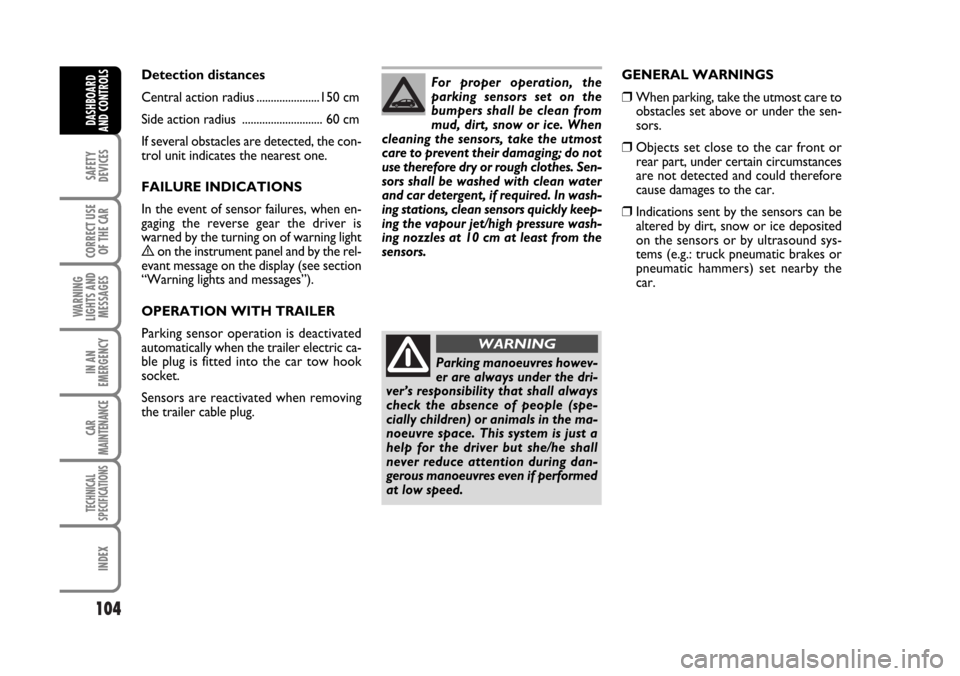
104
SAFETY
DEVICES
CORRECT USE
OF THE CAR
WARNING
LIGHTS AND
MESSAGES
IN AN
EMERGENCY
CAR
MAINTENANCE
TECHNICAL
SPECIFICATIONS
INDEX
DASHBOARD
AND CONTROLS
Detection distances
Central action radius ......................150 cm
Side action radius ............................ 60 cm
If several obstacles are detected, the con-
trol unit indicates the nearest one.
FAILURE INDICATIONS
In the event of sensor failures, when en-
gaging the reverse gear the driver is
warned by the turning on of warning light
èon the instrument panel and by the rel-
evant message on the display (see section
“Warning lights and messages”).
OPERATION WITH TRAILER
Parking sensor operation is deactivated
automatically when the trailer electric ca-
ble plug is fitted into the car tow hook
socket.
Sensors are reactivated when removing
the trailer cable plug.GENERAL WARNINGS
❒When parking, take the utmost care to
obstacles set above or under the sen-
sors.
❒Objects set close to the car front or
rear part, under certain circumstances
are not detected and could therefore
cause damages to the car.
❒Indications sent by the sensors can be
altered by dirt, snow or ice deposited
on the sensors or by ultrasound sys-
tems (e.g.: truck pneumatic brakes or
pneumatic hammers) set nearby the
car. For proper operation, the
parking sensors set on the
bumpers shall be clean from
mud, dirt, snow or ice. When
cleaning the sensors, take the utmost
care to prevent their damaging; do not
use therefore dry or rough clothes. Sen-
sors shall be washed with clean water
and car detergent, if required. In wash-
ing stations, clean sensors quickly keep-
ing the vapour jet/high pressure wash-
ing nozzles at 10 cm at least from the
sensors.
Parking manoeuvres howev-
er are always under the dri-
ver’s responsibility that shall always
check the absence of people (spe-
cially children) or animals in the ma-
noeuvre space. This system is just a
help for the driver but she/he shall
never reduce attention during dan-
gerous manoeuvres even if performed
at low speed.
WARNING
Page 111 of 274
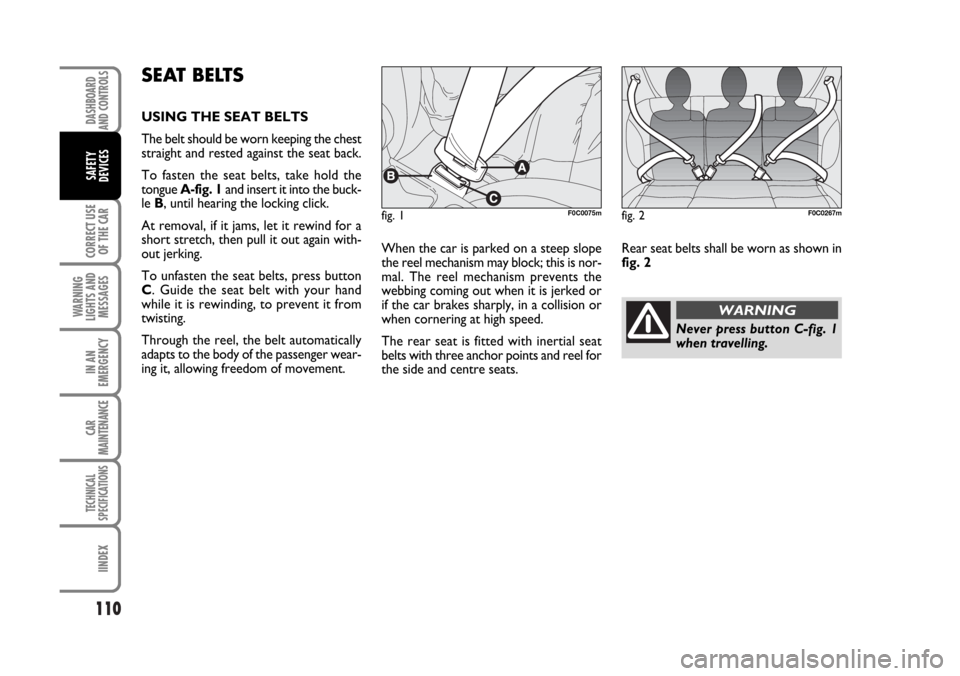
110
CORRECT USE
OF THE CAR
WARNING
LIGHTS AND
MESSAGES
IN AN
EMERGENCY
CAR
MAINTENANCE
TECHNICAL
SPECIFICATIONS
IINDEX
DASHBOARD
AND CONTROLS
SAFETY
DEVICES
When the car is parked on a steep slope
the reel mechanism may block; this is nor-
mal. The reel mechanism prevents the
webbing coming out when it is jerked or
if the car brakes sharply, in a collision or
when cornering at high speed.
The rear seat is fitted with inertial seat
belts with three anchor points and reel for
the side and centre seats.
SEAT BELTS
USING THE SEAT BELTS
The belt should be worn keeping the chest
straight and rested against the seat back.
To fasten the seat belts, take hold the
tongue A-fig. 1and insert it into the buck-
le B, until hearing the locking click.
At removal, if it jams, let it rewind for a
short stretch, then pull it out again with-
out jerking.
To unfasten the seat belts, press button
C. Guide the seat belt with your hand
while it is rewinding, to prevent it from
twisting.
Through the reel, the belt automatically
adapts to the body of the passenger wear-
ing it, allowing freedom of movement.
Never press button C-fig. 1
when travelling.
WARNING
Rear seat belts shall be worn as shown in
fig. 2
fig. 1F0C0075mfig. 2F0C0267m
Page 212 of 274
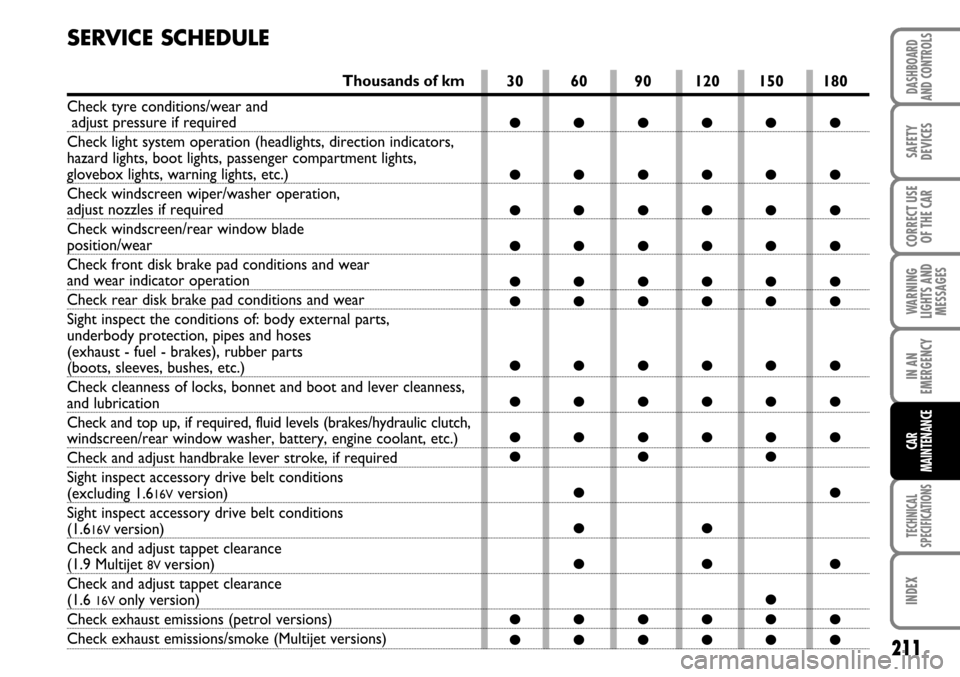
211
WARNING
LIGHTS AND
MESSAGES
TECHNICAL
SPECIFICATIONS
INDEX
DASHBOARD
AND CONTROLS
SAFETY
DEVICES
CORRECT USE
OF THE CAR
IN AN
EMERGENCY
CAR
MAINTENANCE
SERVICE SCHEDULE
30 60 90 120 150 180
●●●●●●
●●●●●●
●●●●●●
●●●●●●
●●●●●●
●●●●●●
●●●●●●
●●●●●●
●●●●●●
●●●
●●
●●
●●●
●
●●●●●●
●●●●●●
Thousands of km
Check tyre conditions/wear and
adjust pressure if required
Check light system operation (headlights, direction indicators,
hazard lights, boot lights, passenger compartment lights,
glovebox lights, warning lights, etc.)
Check windscreen wiper/washer operation,
adjust nozzles if required
Check windscreen/rear window blade
position/wear
Check front disk brake pad conditions and wear
and wear indicator operation
Check rear disk brake pad conditions and wear
Sight inspect the conditions of: body external parts,
underbody protection, pipes and hoses
(exhaust - fuel - brakes), rubber parts
(boots, sleeves, bushes, etc.)
Check cleanness of locks, bonnet and boot and lever cleanness,
and lubrication
Check and top up, if required, fluid levels (brakes/hydraulic clutch,
windscreen/rear window washer, battery, engine coolant, etc.)
Check and adjust handbrake lever stroke, if required
Sight inspect accessory drive belt conditions
(excluding 1.616Vversion)
Sight inspect accessory drive belt conditions
(1.616V version)
Check and adjust tappet clearance
(1.9 Multijet 8V version)
Check and adjust tappet clearance
(1.6 16V only version)
Check exhaust emissions (petrol versions)
Check exhaust emissions/smoke (Multijet versions)
Page 214 of 274
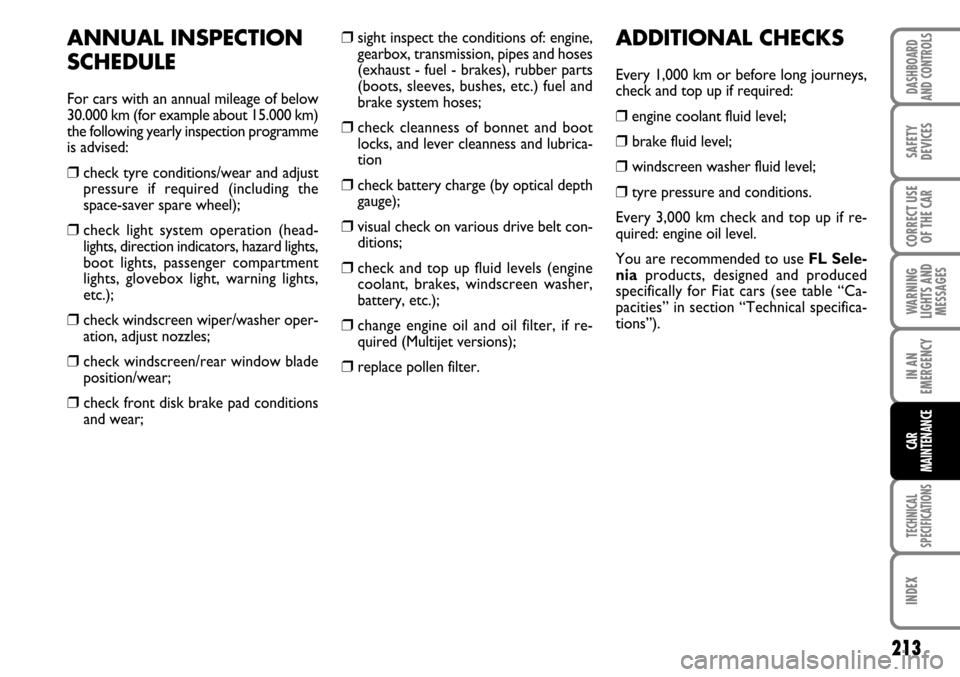
213
WARNING
LIGHTS AND
MESSAGES
TECHNICAL
SPECIFICATIONS
INDEX
DASHBOARD
AND CONTROLS
SAFETY
DEVICES
CORRECT USE
OF THE CAR
IN AN
EMERGENCY
CAR
MAINTENANCE
ANNUAL INSPECTION
SCHEDULE
For cars with an annual mileage of below
30.000 km (for example about 15.000 km)
the following yearly inspection programme
is advised:
❒check tyre conditions/wear and adjust
pressure if required (including the
space-saver spare wheel);
❒check light system operation (head-
lights, direction indicators, hazard lights,
boot lights, passenger compartment
lights, glovebox light, warning lights,
etc.);
❒check windscreen wiper/washer oper-
ation, adjust nozzles;
❒check windscreen/rear window blade
position/wear;
❒ check front disk brake pad conditions
and wear;
❒sight inspect the conditions of: engine,
gearbox, transmission, pipes and hoses
(exhaust - fuel - brakes), rubber parts
(boots, sleeves, bushes, etc.) fuel and
brake system hoses;
❒check cleanness of bonnet and boot
locks, and lever cleanness and lubrica-
tion
❒check battery charge (by optical depth
gauge);
❒visual check on various drive belt con-
ditions;
❒check and top up fluid levels (engine
coolant, brakes, windscreen washer,
battery, etc.);
❒change engine oil and oil filter, if re-
quired (Multijet versions);
❒replace pollen filter.
ADDITIONAL CHECKS
Every 1,000 km or before long journeys,
check and top up if required:
❒engine coolant fluid level;
❒ brake fluid level;
❒ windscreen washer fluid level;
❒tyre pressure and conditions.
Every 3,000 km check and top up if re-
quired: engine oil level.
You are recommended to use FL Sele-
niaproducts, designed and produced
specifically for Fiat cars (see table “Ca-
pacities” in section “Technical specifica-
tions”).
Page 238 of 274

237
WARNING
LIGHTS AND
MESSAGES
INDEX
DASHBOARD
AND CONTROLS
SAFETY
DEVICES
CORRECT USE
OF THE CAR
IN AN
EMERGENCY
CAR
MAINTENANCE
TECHNICAL
SPECIFICATIONS
IDENTIFICATION DATA ................................................... 238
ENGINE CODES - BODYWORK VERSIONS .............. 240
ENGINE .................................................................................... 241
FUEL FEED/IGNITION ........................................................ 243
TRANSMISSION .................................................................... 243
BRAKES ..................................................................................... 244
SUSPENSIONS......................................................................... 244
STEERING ................................................................................. 244
WHEELS .................................................................................... 245
DIMENSIONS .......................................................................... 250
PERFORMANCE ..................................................................... 253
WEIGHTS ................................................................................. 254
CAPACITIES ........................................................................... 257
FLUIDS AND LUBRICANTS ............................................... 259
FUEL CONSUMPTION ........................................................ 261
CO
2EMISSIONS .................................................................... 263
T T
E E
C C
H H
N N
I I
C C
A A
L L
S S
P P
E E
C C
I I
F F
I I
C C
A A
T T
I I
O O
N N
S S
Page 245 of 274
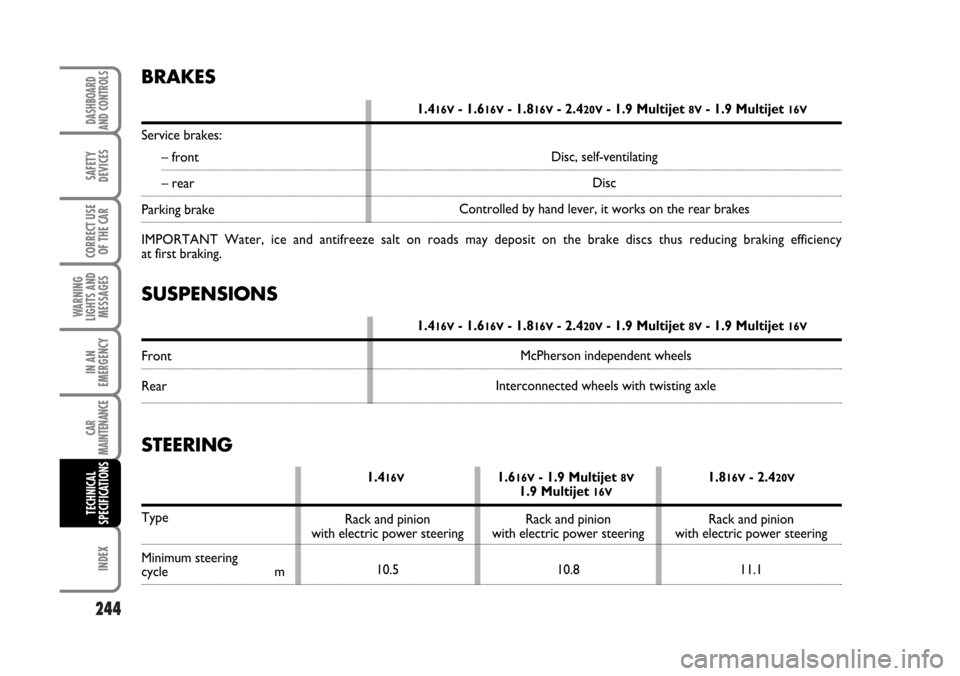
244
WARNING
LIGHTS AND
MESSAGES
INDEX
DASHBOARD
AND CONTROLS
SAFETY
DEVICES
CORRECT USE
OF THE CAR
IN AN
EMERGENCY
CAR
MAINTENANCE
TECHNICAL
SPECIFICATIONS
SUSPENSIONS
1.416V- 1.616V- 1.816V- 2.420V- 1.9 Multijet 8V- 1.9 Multijet 16V
Front
RearMcPherson independent wheels
Interconnected wheels with twisting axle
STEERING
1.416V1.616V- 1.9 Multijet 8V1.816V- 2.420V1.9 Multijet 16V
Type
Minimum steeringcycle m
BRAKES
1.416V- 1.616V- 1.816V- 2.420V- 1.9 Multijet 8V- 1.9 Multijet 16V
Service brakes:
– front
– rear
Parking brake
IMPORTANT Water, ice and antifreeze salt on roads may deposit on the brake discs thus reducing braking efficiency
at first braking.Disc, self-ventilating
Disc
Controlled by hand lever, it works on the rear brakes
Rack and pinion
with electric power steering
10.5Rack and pinion
with electric power steering
10.8Rack and pinion
with electric power steering
11.1
Page 255 of 274

254
WARNING
LIGHTS AND
MESSAGES
INDEX
DASHBOARD
AND CONTROLS
SAFETY
DEVICES
CORRECT USE
OF THE CAR
IN AN
EMERGENCY
CAR
MAINTENANCE
TECHNICAL
SPECIFICATIONS
1.416V1.616V1.816V
WEIGHTS
Weights (kg)(Saloon versions)
Weight empty
(including fluids, 90% fuel
in the tank and no optional)
Payload (*) including the driver:
Maximum admitted loads (**)
– front axle:
– rear axle:
– total:
Towable loads
– trailer with brakes:
– trailer without brakes:
Maximum load on roof (***):
Maximum load on tow hitch
(trailer with brakes):
(*) If special equipment is fitted (sunroof, tow hitch, etc.) the unladen car weight increases thus reducing the specified payload.
(**) Loads not to be exceeded. The driver is responsible for arranging the loads in the boot an/or on the roof so that they com-
ply with these limits.
(***) Lineaccessori Fiat roof rack, max capacity: 50 kg.
(
❍) “DYNAMIC” versions.
(
❒) For specific markets.3-door
1090
1135 (
❍)
510
900
830
1600
1645 (
❍)
1000/500 (
❒)
500
80
605-door
1145
1190 (
❍)
510
900
860
1655
1700 (
❍)
1000/500 (
❒)
500
80
603-door
1150
1195 (
❍)
510
950
830
1660
1705 (
❍)
1100/500 (
❒)
500
80
605-door
1205
1250 (
❍)
510
950
860
1715
1760 (
❍)
1100/500 (
❒)
500
80
603-door
1240
510
990
830
1750
1200/500 (❒)
500
80
605-door
1295
510
990
860
1805
1200/500 (❒)
500
80
60
Page 256 of 274
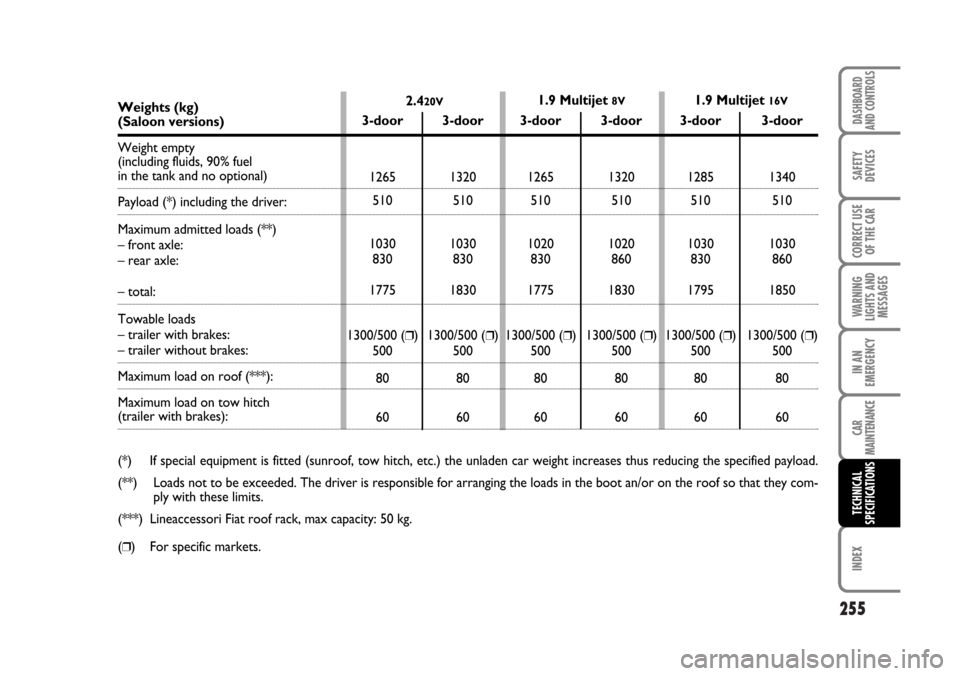
255
WARNING
LIGHTS AND
MESSAGES
INDEX
DASHBOARD
AND CONTROLS
SAFETY
DEVICES
CORRECT USE
OF THE CAR
IN AN
EMERGENCY
CAR
MAINTENANCE
TECHNICAL
SPECIFICATIONS
2.420V1.9 Multijet 8V1.9 Multijet 16VWeights (kg)(Saloon versions)
Weight empty
(including fluids, 90% fuel
in the tank and no optional)
Payload (*) including the driver:
Maximum admitted loads (**)
– front axle:
– rear axle:
– total:
Towable loads
– trailer with brakes:
– trailer without brakes:
Maximum load on roof (***):
Maximum load on tow hitch
(trailer with brakes):
(*) If special equipment is fitted (sunroof, tow hitch, etc.) the unladen car weight increases thus reducing the specified payload.
(**) Loads not to be exceeded. The driver is responsible for arranging the loads in the boot an/or on the roof so that they com-
ply with these limits.
(***) Lineaccessori Fiat roof rack, max capacity: 50 kg.
(
❒) For specific markets.3-door
1265
510
1030
830
1775
1300/500 (
❒)
500
80
603-door
1320
510
1030
830
1830
1300/500 (❒)
500
80
603-door
1265
510
1020
830
1775
1300/500 (❒)
500
80
603-door
1320
510
1020
860
1830
1300/500 (❒)
500
80
603-door
1285
510
1030
830
1795
1300/500 (❒)
500
80
603-door
1340
510
1030
860
1850
1300/500 (❒)
500
80
60